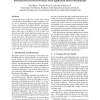Free Online Productivity Tools
i2Speak
i2Symbol
i2OCR
iTex2Img
iWeb2Print
iWeb2Shot
i2Type
iPdf2Split
iPdf2Merge
i2Bopomofo
i2Arabic
i2Style
i2Image
i2PDF
iLatex2Rtf
Sci2ools
IPTPS
2003
Springer
2003
Springer
Structured Peer-to-Peer Overlays Need Application-Driven Benchmarks
Considerable research effort has recently been devoted to the design of structured peer-to-peer overlays, a term we use to encompass Content-Addressable Networks (CANs), Distributed Hash Tables (DHTs), and Decentralized Object Location and Routing networks (DOLRs). These systems share the property that they consistently map a large space of identifiers to a set of nodes in a network, and while at first sight they provide very similar services, they nonetheless embody a wide variety of design alternatives. We present the case for developing application-driven benchmarks for such overlays, give a model of the services they provide applications, describe and present the results of two preliminary benchmarks, and discuss the implications of our tests for application writers. We are unaware of other empirical comparative work in this area.
Considerable Research Effort | Decentralized Object Location And Routing | IPTPS 2003 | Structured Peer-to-peer Overlays |
| Added | 07 Jul 2010 |
| Updated | 07 Jul 2010 |
| Type | Conference |
| Year | 2003 |
| Where | IPTPS |
| Authors | Sean C. Rhea, Timothy Roscoe, John Kubiatowicz |
Comments (0)

